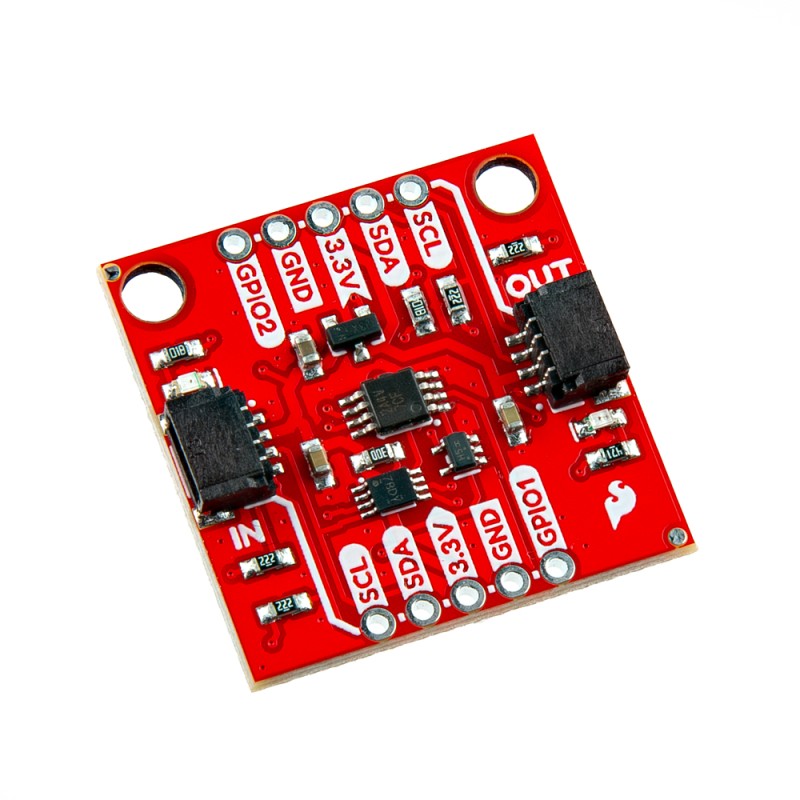






zł36.89 tax excl.
Power switch that enables efficient power management of devices in the Qwiic ecosystem, allowing selective shutdown of devices and energy saving. The module offers I2C bus isolation, additional GPIO pins and works with SparkFun Qwiic Mux, making it easy to control multiple devices in your projects. SparkFun PRT-26784
SparkFun Qwiic Power Switch (QPS) is an innovative solution that enables efficient power management of devices within the Qwiic ecosystem. With QPS, you can selectively turn off Qwiic devices, such as precise GNSS modules, to save energy and extend battery life. The module also features I2C bus isolation, allowing simultaneous use of devices operating at different speeds (100kHz and 400kHz) without interference. This is the perfect solution for projects that require flexibility in managing devices.
QPS also provides two GPIO pins that can function as inputs or outputs, enabling control of other components in your project. It is also compatible with the SparkFun Qwiic Mux, allowing you to control and power multiple devices, even if they share the same I2C address. Thanks to the dedicated Arduino library, integrating QPS into projects is simple, and numerous examples make it easy to utilize functions such as power management, bus isolation, and GPIO control.
Manufacturer BTC Korporacja sp. z o. o. Lwowska 5 05-120 Legionowo Poland sprzedaz@kamami.pl 22 767 36 20
Responsible person BTC Korporacja sp. z o. o. Lwowska 5 05-120 Legionowo Poland sprzedaz@kamami.pl 22 767 36 20
8-channel I2C expander module based on the TCA9548A system. The module has Qwiic connectors and allows communication with many I2C devices that have the same address. Sparkfun BOB-16784
SparkFun Qwiic kit. Contains 10 wires of different lengths and tips. It allows you to connect Qwiic modules to a programming platform or to a prototype board. SparkFun KIT-15081
Qwiic to Grove adapter cable, 100 mm long. Enables interoperability between the SparkFun Qwiic Connect system and Seeed Studio I2C-based Grove boards. SparkFun PRT-15109
Flexible 4-core cable, 50 mm long, terminated on both sides with a Qwiic plug. Sparkfun PRT-17260
The Step-Down D24V3AHV Buck Voltage Regulator module with adjustable output voltage in the range of 4-25V with a wide input voltage range of 4.5-42V and a maximum output current of 300 mA. Pololu 2102
This powerful boost regulator efficiently boosts input voltages as low as 2.9 V to a higher, adjustable output voltage between 9 V and 30 V while allowing an input current as high as 5 A.
No product available!
A passive on/off power switch that provides control and feedback functions, allowing you to start and safely shut down your system with short presses of the button, while a long press forces the power off. The Mk2 version, based on the 74LVC1G175 D-type flip-flop digital design, eliminates the problems of component tolerance and temperature variation, and also offers additional improvements such as a 2A self-resetting fuse, LED indicators, and the ability to connect a larger external button. SparkFun SPX-25365
Step-Up/Step-Down DC-DC converter module. It has an input voltage of 2.8 to 22 V, an output voltage of 9 V and a maximum output of 2.5 A to 3.5 A. Pololu 4983
The Step-UpU1V11A Buck Voltage Regulator module with adjustable output voltage 2-5.25V, input voltage range of 0.5-5.5V and a maximum output current of 1.2A. Pololu 2560
Step-Up/Step-Down DC-DC converter module. It has an input voltage of 2.8 to 22 V, an output voltage of 6 V and a maximum output of 2.5 A to 3.5 A. Pololu 4981
Step-Down converter D36V28F5 with an output voltage of 5 V, an input voltage from 5.3 to 50 V and a maximum output current of 4 A. Pololu 3782
Step-Down converter with adjustable output voltage from 4.2 V to 15 V and output voltage up to 45 V. It is equipped with reverse voltage protection, input undervoltage lockout, overload and short circuit protection. Pololu 4854
DC-DC Step-Down converter module with 5V output voltage and 1A output current. The module can be a replacement for the popular LM7805 regulator.
Step-Up DC-DC converter module. It has an input voltage of 1.3 to 16 V, an output voltage of 9 V and a maximum input of up to 2 A. Pololu 4944
The STEVAL-ISB043V1 is a Qi-based 2.5 W wireless power receiver evaluation board based on the STWLC33 and suitable for wearable applications. The STEVAL-ISB043V1 provides a complete kit, which includes the STWLC33 IC, firmware, layout and tools
A switching converter that regulates 24V voltage from an input range of 2.6V to 20V. It offers high efficiency of 70-95% and the ability to operate with a continuous input current of up to 900mA and a peak current limit of 2.2A. With a switching frequency of 1.6MHz and a power-saving mode, it is suitable for both high-performance and low-power applications. Pololu 5588
The Step-Down D24V6F9 Buck Voltage Regulator module gives the output voltage of 9V with a wide input voltage range of 11.5-42V and a maximum output current of 600 mA. Pololu 2108
No product available!
Adapter with 3.3V voltage regulator designed for NRF24L01 modules with 8-pin connector
No product available!
Step-up DC-DC converter module, 0.9-5V input voltage, 5V output voltage (max. 500 mA) connected to the USB socket. There is a diode on the board indicating the power connection
The 12V 10W USB Step-Up Converter Module converts 4.2-5.2V input voltage to 12V DC output voltage, with a maximum current of 1A and a conversion efficiency of 96%. The device can operate in a wide temperature range, from -40°C to 85°C, which makes it ideal for powering various electronic devices in harsh environments.

Power switch that enables efficient power management of devices in the Qwiic ecosystem, allowing selective shutdown of devices and energy saving. The module offers I2C bus isolation, additional GPIO pins and works with SparkFun Qwiic Mux, making it easy to control multiple devices in your projects. SparkFun PRT-26784
